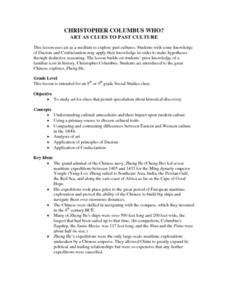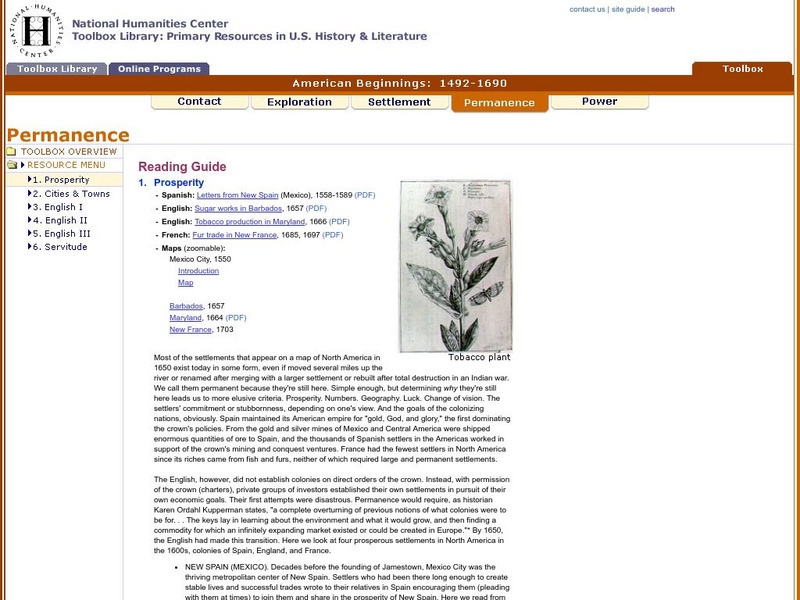Curated OER
Social Studies: Cooking Methods - Past and Present
Fourth graders identify geographic regions (Texas' Edwards Plateau) and sequence steps in the hot rock cooking process. They compare and contrast prehistoric and contemporary cooking methods. Students conduct online research and record...
Curated OER
Marco Polo Takes A Trip
Young scholars identify Marco Polo and discuss why he took his trip, indicate on map routes Marco Polo took to China and back, describe challenges of traveling along Silk Road, list several interesting aspects of 13th Century Chinese...
Curated OER
Development of the English Colonies
Students research one of the original 13 colonies using the included worksheet. They also record their findings on a poster board to use during a class presentation. Students then take notes on the presentations using the provided...
Curated OER
Utah: State History
In this Utah state history worksheet, students read two and a half pages of information about Utah and complete 10 true and false questions.
Curated OER
Oral History: Interviewing Elders
Sixth graders examine oral history traditions. They interview family members about their childhoods and compare them to their own. Students use the collected information to make posters, letters, essays, or poems about their research.
Curated OER
What's Cookin' at Honey Creek?
Fourth graders are introduced to the process of prehistoric hot rock cooking in earth ovens on the Edwards Plateau of Texas. They explain the steps used in the hot rock cooking process.
Curated OER
Digging Deeper: Mission San Sabá
Seventh graders view a painting of the destruction of Mission San Saba in Texas. They discuss the painting and identify information that they can infer from the painting.
Curated OER
Boomtime
High schoolers view a short film about the rise of prosperity after World War II. They examine the role of status symbols and owning vehicles. They compare and contrast advertisements from the 1950's with those from the 1990's.
Curated OER
Mapping and Personifying Nations
Eleventh graders analyze the geography, actions, and relationships of countries involved in World War II. They create a map of Europe, Northern Africa, and the Pacific, and analyze and evaluate their self-made map of Europe and the...
Curated OER
Christopher Columbus Who?
Students recreate a "60-minutes" interview using cue cards and historical information on the Chinese explorer Zheng He. This lesson is an excellent introduction to World History during the 1400's.
Curated OER
COMPARE AND CONTRAST HISTORICAL TIME PERIODS
Students make comparisons and show contrasts between two similar or dissimilar art objects. Historical time periods will be indicated by dress and inventions.
Curated OER
Gone to Texas
Fourth graders role play as empresarios attempting to bring colonists to Texas in the 1800's. They create an advertisement that encourages the immigrants to come to Texas.
Curated OER
English Colonization
Fifth graders discuss their prior knowledge of what colonization means and give their opinions of why someone would want to start a colony. After recording their answers on web map they read about the English colonization in their books;...
Curated OER
Native People of the Caribbean
Eleventh graders use a map and locate and define the Caribbean region and then work in groups to read the passage and timeline. The groups' reader will read the passage aloud and the recorder makes a list of why colonists used slave...
Curated OER
The News Spreads
Students examine ethnicity and the Gold Rush. In this lesson on the Gold Rush, students research the different ethnic groups present at the Gold Rush. Students will work in groups to answer questions concerning ethnicity and fill out an...
Curated OER
Learning Empathy Through Art
Students observe the painting, From That Day On, by Ben Shahn, and reflect on the story of the Lucky Dragon. They research and discuss the physical and emotional side effects on the Japanese people after the atomic bomb was dropped.
Texas Education Agency
Texas Gateway: Exploration and Colonization of America
Given short summaries about the reasons for European exploration and colonization of North America, students will compare English and Spanish settlements in the New World.
University of California
Uc Santa Barbara: What Brought the Europeans to America?
Short essay addresses reasons that brought the Europeans to America. Covering many important points, he also provides compelling reasons and a map.
National Humanities Center
National Humanities Center: Toolbox Library: Prosperity, American Beginnings: 1492 1690
Four original source accounts, and four related maps, of successful English, French, and Spanish settlements in North America and the Caribbean that explain the qualities of these settlements and their reasons for permanence and prosperity.
University of Calgary
University of Calgary: Africa the Search for Gold and Slaves
Historical background of the reasons for European exploration of Africa. Tutorial Links to further European trade and exploration.
Library of Congress
Loc: Mediterranean World on the Eve of Conquest
The Library of Congress provides an essay on the reasons for exploration during the 15th century.





















